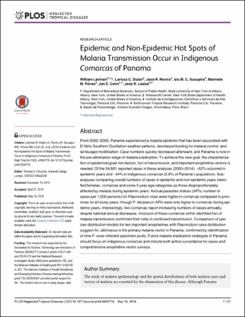Mostrar el registro sencillo del ítem
Epidemic and Non-Epidemic Hot Spots of Malaria Transmission Occur in Indigenous Comarcas of Panama
| dc.contributor.author | Lainhart, William | |
| dc.contributor.author | Dutari, Larissa C. | |
| dc.contributor.author | Rovira, Jose R. | |
| dc.contributor.author | C. Sucupira, Izis M. | |
| dc.contributor.author | Póvoa, Marinete M. | |
| dc.contributor.author | Conn, Jan E. | |
| dc.contributor.author | Loaiza, Jose R. | |
| dc.date.accessioned | 2020-07-07T06:22:20Z | |
| dc.date.available | 2020-07-07T06:22:20Z | |
| dc.date.issued | 2016-05-16 | |
| dc.identifier.other | https://doi.org/10.1371/journal.pntd.0004718 | |
| dc.identifier.uri | http://repositorio-indicasat.org.pa/handle/123456789/179 | |
| dc.description | From 2002–2005, Panama experienced a malaria epidemic that has been associated with El Niño Southern Oscillation weather patterns, decreased funding for malaria control, and landscape modification. Case numbers quickly decreased afterward, and Panama is now in the pre-elimination stage of malaria eradication. To achieve this new goal, the characterization of epidemiological risk factors, foci of transmission, and important anopheline vectors is needed. Of the 24,681 reported cases in these analyses (2000–2014), ~62% occurred in epidemic years and ~44% in indigenous comarcas (5.9% of Panama’s population). Subanalyses comparing overall numbers of cases in epidemic and non-epidemic years identified females, comarcas and some 5-year age categories as those disproportionately affected by malaria during epidemic years. Annual parasites indices (APIs; number of cases per 1,000 persons) for Plasmodium vivax were higher in comarcas compared to provinces for all study years, though P. falciparum APIs were only higher in comarcas during epidemic years. Interestingly, two comarcas report increasing numbers of cases annually, despite national annual decreases. Inclusion of these comarcas within identified foci of malaria transmission confirmed their roles in continued transmission. Comparison of species distribution models for two important anophelines with Plasmodium case distribution suggest An. albimanus is the primary malaria vector in Panama, confirmed by identification of nine P. vivax-infected specimen pools. Future malaria eradication strategies in Panama should focus on indigenous comarcas and include both active surveillance for cases and comprehensive anopheline vector surveys. | en_US |
| dc.description.abstract | From 2002–2005, Panama experienced a malaria epidemic that has been associated with El Niño Southern Oscillation weather patterns, decreased funding for malaria control, and landscape modification. Case numbers quickly decreased afterward, and Panama is now in the pre-elimination stage of malaria eradication. To achieve this new goal, the characterization of epidemiological risk factors, foci of transmission, and important anopheline vectors is needed. Of the 24,681 reported cases in these analyses (2000–2014), ~62% occurred in epidemic years and ~44% in indigenous comarcas (5.9% of Panama’s population). Subanalyses comparing overall numbers of cases in epidemic and non-epidemic years identified females, comarcas and some 5-year age categories as those disproportionately affected by malaria during epidemic years. Annual parasites indices (APIs; number of cases per 1,000 persons) for Plasmodium vivax were higher in comarcas compared to provinces for all study years, though P. falciparum APIs were only higher in comarcas during epidemic years. Interestingly, two comarcas report increasing numbers of cases annually, despite national annual decreases. Inclusion of these comarcas within identified foci of malaria transmission confirmed their roles in continued transmission. Comparison of species distribution models for two important anophelines with Plasmodium case distribution suggest An. albimanus is the primary malaria vector in Panama, confirmed by identification of nine P. vivax-infected specimen pools. Future malaria eradication strategies in Panama should focus on indigenous comarcas and include both active surveillance for cases and comprehensive anopheline vector surveys. | en_US |
| dc.language.iso | eng | en_US |
| dc.rights | info:eu-repo/semantics/openAccess | |
| dc.rights | https://creativecommons.org/licenses/by-nc-sa/4.0/ | |
| dc.subject | Epidemic | en_US |
| dc.subject | Non-Epidemic | en_US |
| dc.subject | Hot Spots | en_US |
| dc.subject | Malaria | en_US |
| dc.subject | Indigenous Comarcas | en_US |
| dc.subject | Panama | en_US |
| dc.title | Epidemic and Non-Epidemic Hot Spots of Malaria Transmission Occur in Indigenous Comarcas of Panama | en_US |
| dc.type | info:eu-repo/semantics/article | en_US |
| dc.type | info:eu-repo/semantics/publishedVersion |

